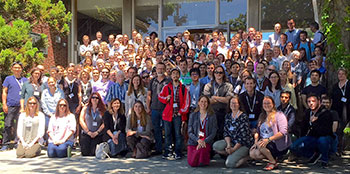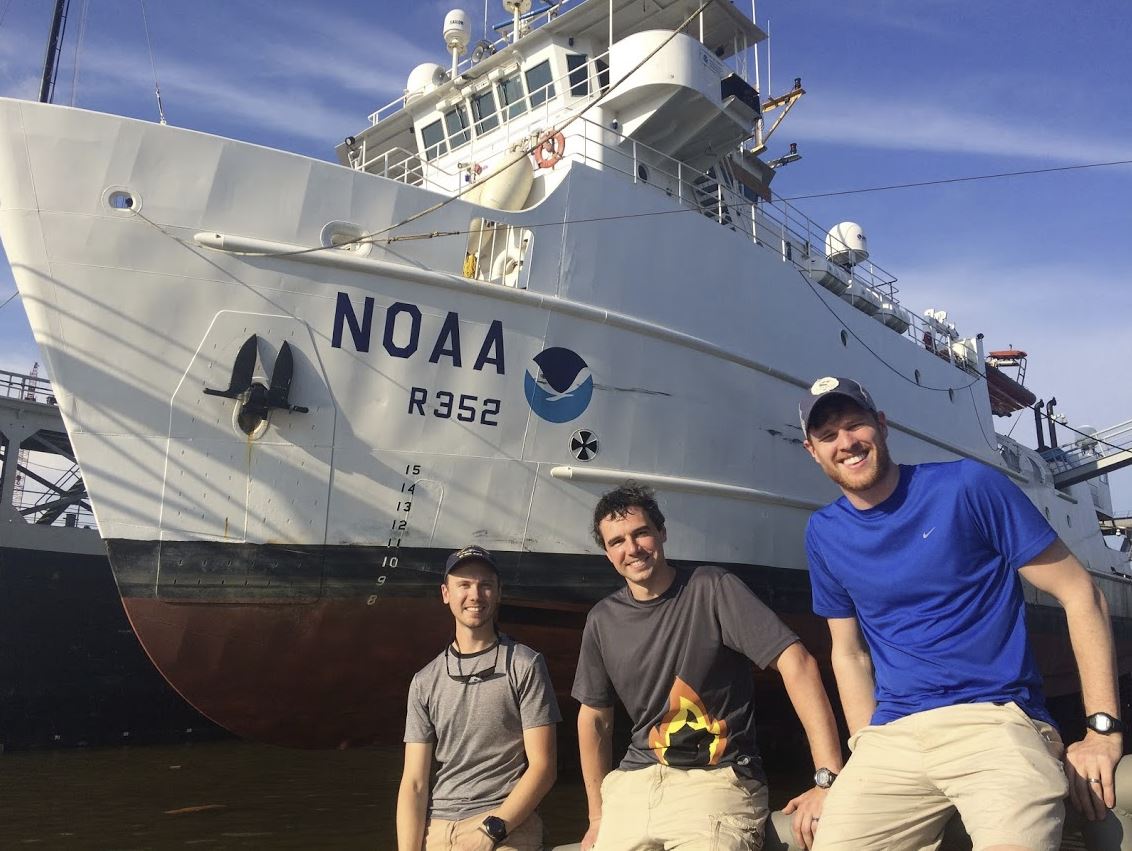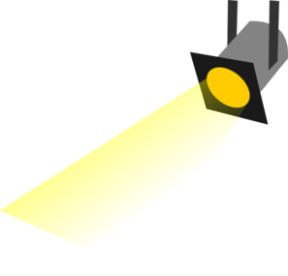In the ocean's twilight zone, tiny organisms may have giant effect on Earth's carbon cycle
(Source: FSU News)
 |
|
 |
Stukel and his team found that hordes of microorganisms called phaeodarians, depicted above, could be playing an outsized role in the global carbon cycle.
|
Deep in the ocean's twilight zone, swarms of ravenous single-celled organisms may be altering Earth's carbon cycle in ways scientists never expected, according to a new study from Florida State University researchers.
In the area 100 to 1,000 meters below the ocean's surface - dubbed the twilight zone because of its largely impenetrable darkness - scientists found that tiny organisms called phaeodarians are consuming sinking, carbon-rich particles before they settle on the seabed, where they would otherwise be stored and sequestered from the atmosphere for millennia.
This discovery, researchers suggest, could indicate the need for a re-evaluation of how carbon circulates throughout the ocean, and a new appraisal of the role these microorganisms might play in Earth's shifting climate.
Climate and Atmospheric Science, provides new insight into the question of land development's effect on seasonal climate processes.
|
|
 |
|
Dr. Mike Stukel, assistant professor of Earth, Ocean and Atmospheric Science
|
 |
The findings were published in the journal
Limnology and Oceanography. Lead researcher and FSU Assistant Professor of Oceanography
Mike Stukel, who conducted the study with the California Current Ecosystem Long-Term Ecological Research program, investigates the biological pump - the process by which carbon is transported from the surface to the deep ocean.
|
4th Blue Planet Symposium
In June, COAPS director, Dr. Eric Chassignet, participated in this year's GEO Blue Planet Symposium, which took place in Toulouse, France The symposium serves as a forum for discussion of ocean and coastal information needs for sustainable development, Blue Growth and societal awareness. The symposium brought together producers of ocean and coastal information and current and potential users of ocean and coastal information, who shared their experience with the audience. Chassignet presented on the his work with the GODAE OceanView Science Team, which provides coordination and leadership in consolidating and improving global and regional ocean analysis and forecasting systems on an international level.
|
|
|
Pictured (l-r): Eric Chassignet with Brian Arbic (University of Michigan) and COAPS alum, Romain Bourdalle-Badie (Mercator Ocean)
|
At the "Research as Art" event at the Earth Science Information Partners (ESIP) Summer Meeting, MDC Lead Programmer Jocelyn Elya presented this piece-a beautiful accident that appeared while tinkering with Python and matplotlib's quiver tools. The data behind the image can be downloaded from the COAPS Simplified Daily Swath product
|
Teaming up with New York State to Study Heat Vulnerability
Learning "All About Climate"
Danny Brouillette, Service Climatologist with the Florida Climate Center, presented to a group of school-age children at the Dr. B.L. Perry, Jr., branch of the Leon County Public Library in Tallahassee. His presentation, entitled "All About Climate and Climatologists" was part of that branch library's "Brainshops" series, which is a series of free summer-time science workshops presented by topical experts from the Tallahassee area.
|
|
|
Student Activities and Achievements
|
A critical part of COAPS student experiences are opportunities to
share and present research findings with the larger academic research community.
 Tom Kelly Tom Kelly (MS student, oceanography) presented at the
Ocean Carbon and Biogeochemistry Summer Workshop at Woods Hole Oceanographic Institution in June. Kelly presented a poster entitled "California Current Ecosystem: Are there inter-annual changes in primary production, mesozooplankton grazing & export efficiency?"
 Graduate students
Tom Kelly (left) and
Taylor Shropshire (right) along with
Dr. Mike Stukel (center) participated in a research cruise in May. The cruise was part of a NOAA Restore Act-funded project looking
looking at the supply of nutrients into the Gulf of Mexico oligotrophic ecosystem in support of larval fishes, particularly the endangered Blue Fin Tuna. This photo was taken at the end of the cruise (5/20/18) in Pascagoula, MS. The ship was dry docked in order to effect repairs. Also onboard the cruise were collaborators from RSMAS in Miami (including the University of Miami & Southeast Fisheries NOAA), the Scripps Institute of Oceanography, and the University of Hawaii.
 Heather Roman-Stork
Heather Roman-Stork successfully defended her master's thesis in June. Roman-Stork will be pursuing her PhD at the University of South Carolina with Dr. Subrahmanyam Bulusu who leads the Satellite Oceanography Laboratory in Columbia, SC.
|

COAPS recently caught up with one of our alumni, Dr. David Legler, who agreed to share some memories of his years at FSU and update us on his activities and career since then.
"Grab hold of new opportunities!"
By David Legler, Director, Ocean Observing and Monitoring,
NOAA Climate Program Office
|
|
 |
|
Dr. David Legler
|
 |
I joined MASIG (Mesoscale Air-Sea Interaction Group), the forerunner to COAPS, in the fall of 1980 as I pursued my BS in meteorology. Little did I realize at the time I was to remain at FSU for nearly 20 years, and in the process earn all three college degrees, get married, and start a family. Initially I was an undergraduate programmer, and went on to become a contributor to innumerable MASIG/COAPS projects in air-sea interaction, ocean remote sensing, ocean data assimilation, assembling and improving ocean-based meteorology data, and finally using climate information for the benefit of agricultural interests. One of the more interesting responsibilities I had was to supervise 10 advanced high school students and six professionals for several summers as they drew and digitized tropical Pacific wind maps. The period 1980 to 2000 was a time of great growth, and I was given the opportunity by Dr O'Brien to work with many distinguished leaders across a wide range of disciplines and help the group grow and become wildly successful. I also had a small hand in helping many COAPS grad students, post docs, and others. Dr O'Brien offered me many opportunities to sink or swim in building my own career. It's fantastic to see this tradition continuing under Eric's leadership.
One of the interests I had in the 1990s was contributing leadership towards national and international research programs (e.g. TOGA, TOGA-COARE, WOCE, and GODAE). At the time I didn't think the academic/professor career path was a good fit for me, so I accepted an offer to become the first director of the
US CLIVAR Project Office in Washington, DC. I didn't know at the time how Washington (and the Federal Agencies) really worked and how important program managers really were (Full Disclosure: Earlier in my career I wondered what those "program managers" in Washington did with all their spare time since they didn't do research!). As the US CLIVAR director, I managed to bring together the scientific community to generate ideas that excited the fantastic program managers at NOAA, NASA, and NSF. We started several new inter-agency projects focusing on drought, MJOs, ocean salinity, ocean mixing, North American Monsoons, and Climate Process Teams (CPTs) that have left behind a substantial legacy for US CLIVAR.
 |
|
 |
David Legler (left), Sergey Belov (NODC-Russian Federation), and Tom Cuff (director NOAA Ocean Prediction Center) who lead the three committees of JCOMM (WMO-IOC Joint Technical Commission for Oceanography and Marine Meteorology) at a recent JCOMM meeting in Brest, France.
|
My unusual career path next took me to NOAA where I currently lead the
Ocean Observing and Monitoring Division (OOMD); a group of about 12 outstanding program managers and other professionals who manage NOAA's contributions to the sustained global ocean observing system and the Arctic region. Anyone who has used data from Argo, PIRATA, RAMA, XBTs, the global drifter program, GO-SHIP/Repeat Hydrography, and several other observing networks can thank NOAA (our program) and its multiple international partners. These observations underpin a huge range of research and daily services (e.g. from forecast centers). New technologies (e.g.
https://www.pmel.noaa.gov/itae/follow-saildrone-2018) provide exciting opportunities for ocean observing. As my career has demonstrated...grab hold of new opportunities!
|
|
Recent Publications
COAPS authors are in bold.
|
| Ansong, J.K., B.K. Arbic, H.L. Simmons, M.H. Alford, M.C. Buijsman, P.G. Timko, J.G. Richman, J.F. Shriver, and A.J. Wallcraft, 2018: Geographical Distribution of Diurnal and Semidiurnal Parametric Subharmonic Instability in a Global Ocean Circulation Model. J. Phys. Oceanogr., 48, 1409-1431,
Robinson, W., S. Speich, and E. Chassignet, 2018. Exploring the interplay between ocean eddies and the atmosphere, Eos, 99, https://doi.org/10.1029/2018EO100609. Published on 28 June 2018.
Stukel MR, M. Décima, T.B. Kelly, 2018. A new approach for incorporating 15N isotopic data into linear inverse ecosystem models with Markov Chain Monte Carlo sampling. PLoS ONE 13(6): e0199123. https://doi.org/10.1371/journal.pone.0199123
|
|